Where is Lahore?
Lahore, the capital city of the Punjab province in Pakistan, is a historic urban center known for its rich culture, vibrant life, and significant economic contributions. Situated near the eastern border with India, Lahore stands as a testament to centuries of evolution, from a small walled city to a sprawling metropolis. As one of the most important cities in South Asia, Lahore has a strategic geographical and cultural significance that continues to shape its development.
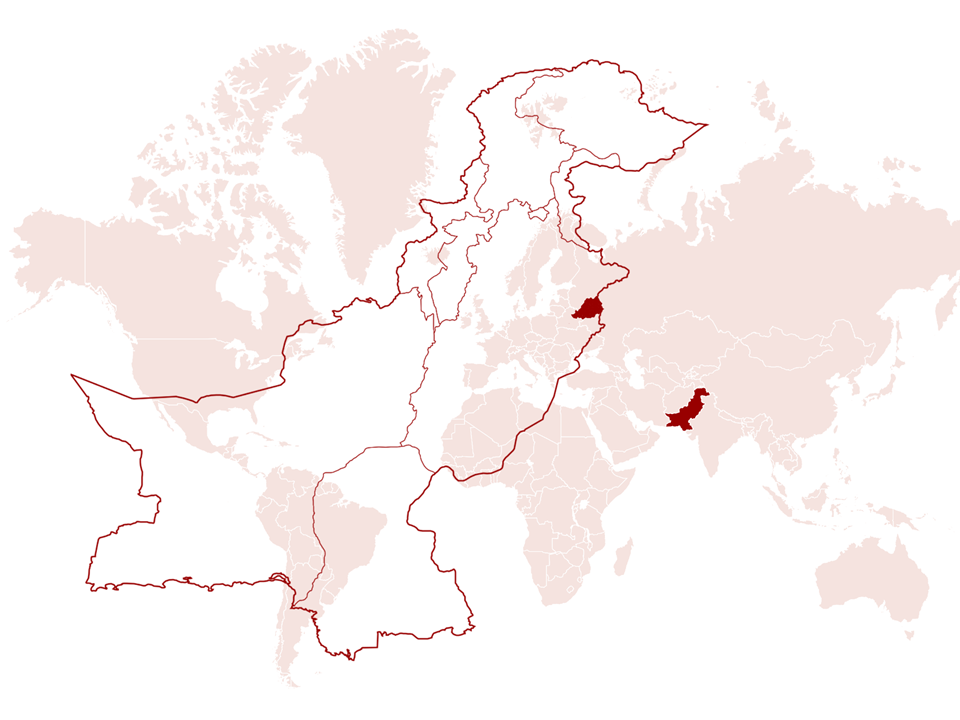
Urban Expansion
Lahore is primarily located on the east side of the Ravi River and has undergone significant expansion over the last few decades. With an average annual growth rate of more than 3.5%, the city’s boundaries have been steadily extending, particularly to the east. Unlike many major cities which are densely populated, Lahore’s extensive area allows for a more spread-out population distribution. The map below illustrates Lahore’s eastward growth, marking it as one of the largest cities in the world by area.
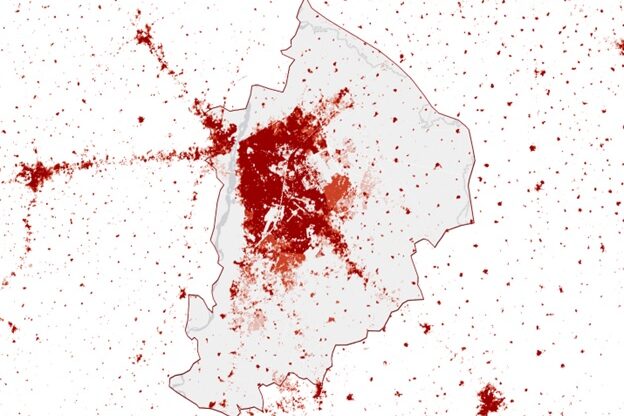
Strategic Planning
The trajectory of Lahore’s development began with its first Land Use Plan in 1975, enacted under the Lahore Development Authority Act. This foundational document laid the groundwork for the city’s structured growth. However, there was a significant lapse in planning until the release of a master plan for 2021. Post-2002, detailed master plans have been sparse, with the only notable exception being the draft for the 2050 master plan. This gap in strategic planning highlights a critical need for continuous and forward-thinking approaches to urban development.


The government structure dealing with urban development is complex and has a top down approach. This structure deals with plans and allocates budgets for local developments. Although this setting ensures a high degree of control and implementation of national plans, it also promotes bureaucracy and hinders fast agile development in cities.

Problems and Challenges Related to Fast Urban Expansion
Rapid expansion, while a sign of a thriving city, comes with its set of challenges. The Integrated Master Plan for 2021 identifies, among others, three main challenges:
- Housing: As the city grows, the demand for housing also escalates, often leading to skyrocketing prices and inadequate housing supplies for lower-income groups.
- Transport: With urban spread, ensuring efficient transportation networks that can service the entire city becomes increasingly challenging.
- Water and Sanitation: Providing clean water and effective sanitation to a growing population distributed over a larger area is a logistical challenge that requires advanced infrastructure and planning.
These challenges can be linked to different sustainable development goals. Linking these challenges to the framework provided by the UN, allows for different opportunities to be identified:
- A Housing Policy and Sustainable Urban Mobility Plan that would allow for strategic planning and a more organized development with clear targets.
- Sanitation and infrastructure plan that would allow for a strategic planning and development of critical sanitation infrastructure taking into account the development patterns.
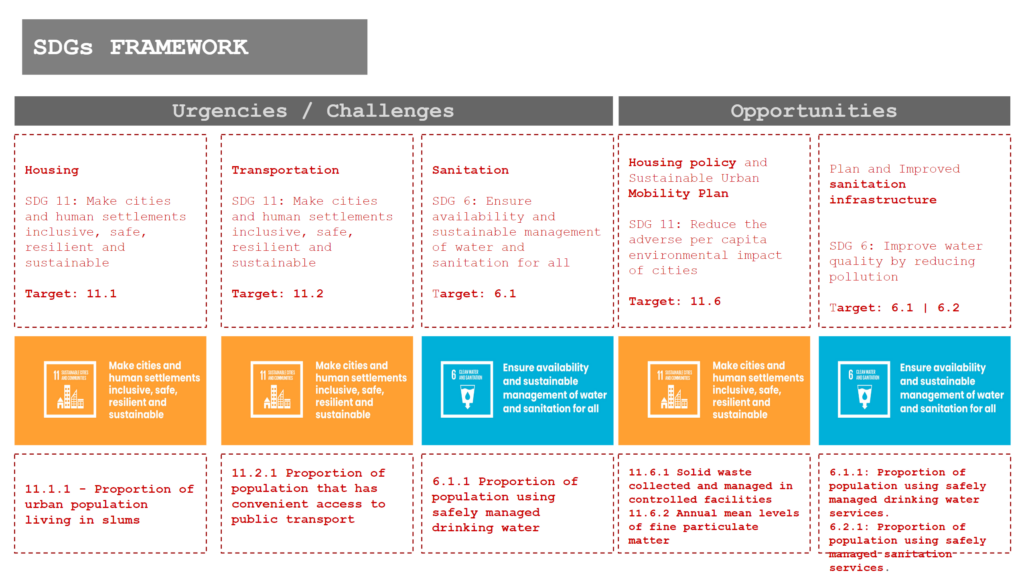
2050 Vision
Looking ahead to 2050, Lahore envisions itself as the striving green city and there already exists a Master Plan presenting the vision for 2050. However, to ensure this vision is reached, we recommend the city of Lahore to take into account different analysis and develop the document presented in the opportunities section.
New Housing Policy
To accommodate its expanding population, Lahore should implement a new housing policy aimed at providing affordable housing solutions and addressing the needs of various income groups.
By studying over 40,000 properties for sale in Lahore, we were able to identify different hotspots. The special analysis we conducted revealed two hotspots with high prices. The same hotspots were identified as having the highest number of bedrooms, indicating properties with many bedrooms and high prices.
However, when analyzing the properties and classifying them depending on their size, two different hotpots appeared. Corelating that information with information related to prices, we can notice that those two new hotspots have low prices, few bedrooms and high property size. Looking at the population density map, we can notice that those two areas have a high population density, leading us to think that those properties are utilized by many citizens who share the same room. We strongly recommend that this sort of analysis are taken into account when developing a new housing policy.


Sustainable Urban Mobility Plan
Transport is connected to housing. A spatial analysis was conducted on all the roads in Lahore, more precisely motorways as well as class 1,2, and 3 roads. Spatial Integration was calculated for a distance of 1200, 800 and 400 meters and areas with high integration were identified in the network. Areas with high integration are suitable for commercial activities, public services and amenities, public transportation hubs, cultural and entertainment venues, public spaces and parks, residential developments and office and business districts.
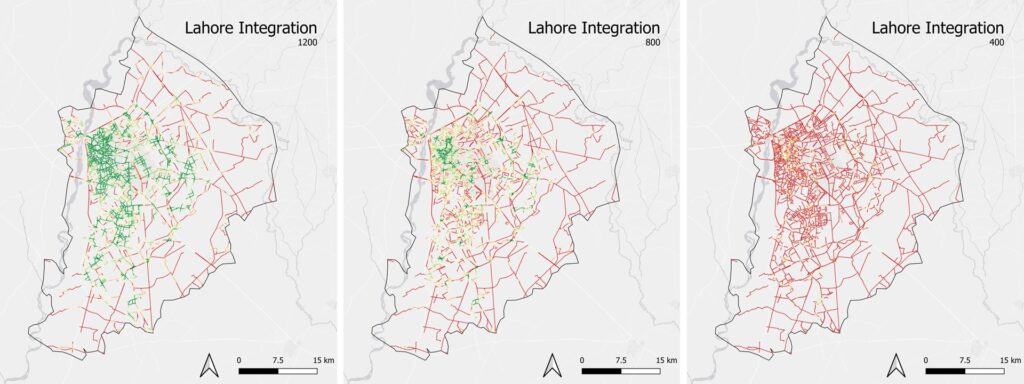
The metric of Choice was also calculated for the city of Lahore using the same distances. Places with high choice values are suitable for transportation networks but also for interventions to optimize traffic flows. commercial activities, civic and cultural sites, healthcare facilities, police stations, recreational areas.
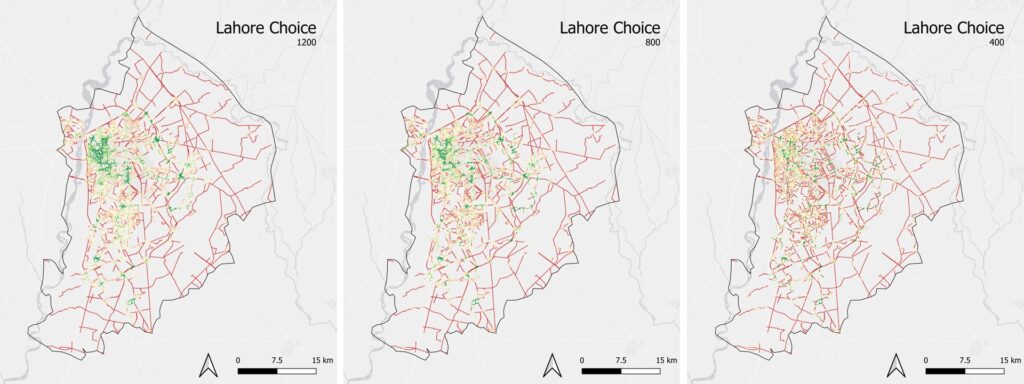
In the same time, different parts of the Lahore Street Network were identified as having High Integration and Low Choice (HILC). We believe these are areas that show potential for development within a network and that are suitable for Community building, Pedestrian-friendly Environments and Slow Streets, Startup Hubs, Mixed-use Development, Incremental Urbanism
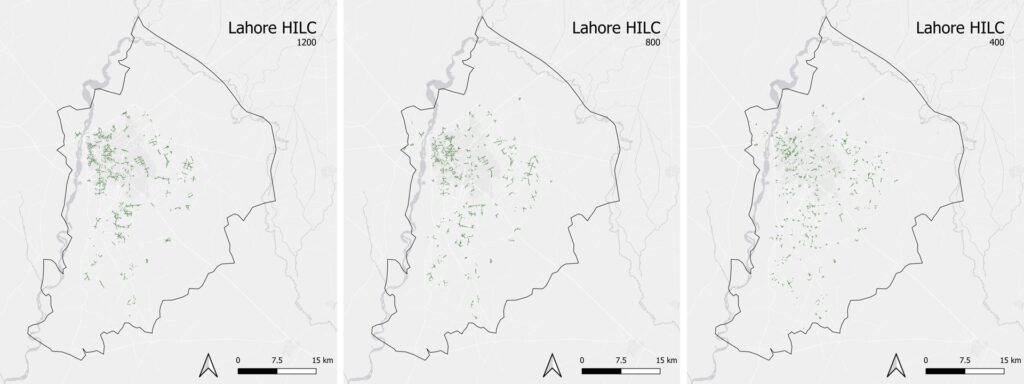
A comprehensive mobility plan that would take into account these types of analysis could promote sustainable transport options to reduce congestion, pollution, and travel time, and make the future city more accessible and environmentally friendly.
Critical Infrastructure Plan
An analysis on the drinkable water wells in the city was also conducted. The analysis shows that although the water wells have good spatial coverage on a global scale, they are not integrated in a central water system and do not cover areas of high density on a local scale. Such aspects should be considered when planning the water infrastructure in the expending city.
Analysis on the wastewater canalis in the city revealed partial coverage of the city. Furthermore, the strategic documents consulted indicate the fact that these canals are use of deposit grounds for waste and get clogged. As a direct effect of poor maintenance and usage of these canals, they are unable to function properly in time sof rains that flood regularly. Moreover, because of the waste that is thrown in by the citizens, they present a environmental hazard risk.

Upgrading and expanding essential infrastructure will be crucial to support Lahore’s growth. This includes water supply, waste management, energy solutions, and a proper digital infrastructure to support the correct functioning of such systems. However, all these solutions should be paced in a strategic document that would ensure that such long term projects are developed by the city future leaders.
Ensuring Citizens’ Needs are Met
Integrating network analysis, current housing data, and expansion patterns into the ongoing development of the MasterPlan for 2050 is key. This plan, which is still under development, will guide the city’s growth in a structured and efficient manner, ensuring that the needs of all residents are considered. We thus would recommend the city of Lahore to involve citizens in the development of the future strategic plans. This would ensure that their needs are met and they will be happy to live in the city and accept it’s growth. For this to happen, a series of stakeholders should be involved to negotiate the future of the city. The map below presents the relevant stakeholders depending on their power and influence.
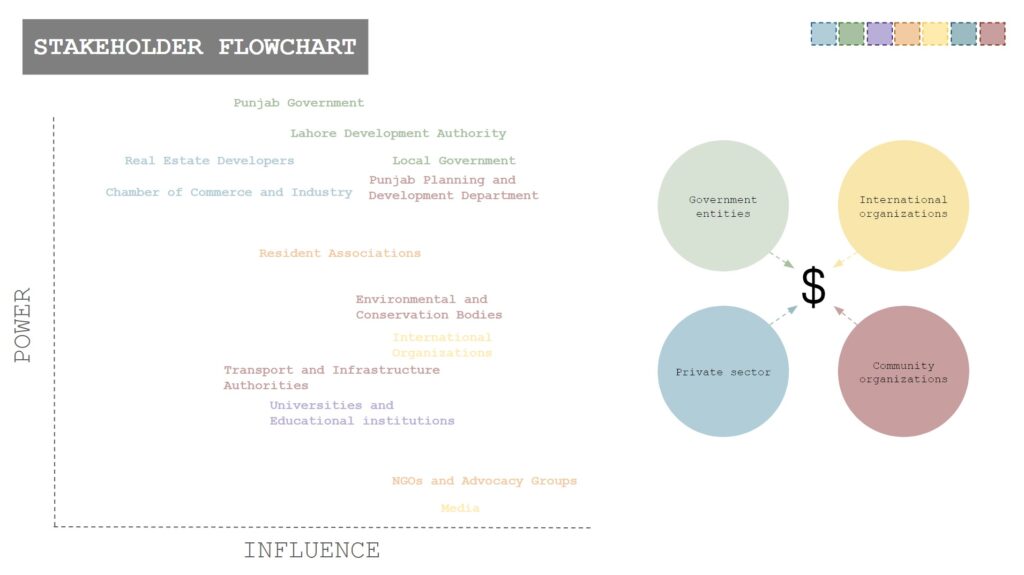
Financing
The realization of Lahore’s 2050 vision will require substantial investment. Currently the city is highly dependent on governmental financing. We would thus recommend the city of Lahore to:
- Attract Foreign Investments: Opening the city to international investors could help reduce dependency on national funds, bringing in fresh capital for large-scale projects.
- Engagement with Local Councils: By involving local councils, Lahore could aim to improve the likelihood of receiving loans from international financial institutions. This approach could also ensure that the plans have a higher chance of successful implementation.
As Lahore moves towards its grand vision for 2050, the city stands on the cusp of transformative growth that will redefine its identity and role on both a national and international scale. With strategic planning, investment, and a commitment to sustainable development, Lahore is poised to become a model future city in the heart of South Asia.

